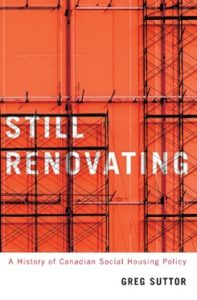
The federal government is currently making decisions on its promised National Housing Strategy, and its 2017 budget has announced the funding involved. It seems timely to ask: What can we learn from the history of social housing policy in Canada that is relevant today?
In the government’s election platform and budget, affordable housing is positioned as social infrastructure: a public good that calls for public investment. The underlying premise is that housing is a system that needs to be managed. If it’s left to chance, shortfalls and inequities result, with the biggest impact on young adults, newcomers, Indigenous people and some ethnoracial groups — all of whom are already disadvantaged in the labour market.
Housing is a wobbly pillar of social policy (as a housing wonk once said), and nowhere more so than in Canada. Most Canadians buy, sell and rent their housing in the market, and don’t see it as being part of infrastructure or social policy. Other more mainstream needs compete for the public dollar. On a per capita basis, the United States creates more subsidized rentals per year than we do, and offers far more subsidies to low-income private rental tenants. Canada’s peak period for social housing was a generation ago.
During the 2016 National Housing Strategy consultations, the strongest voices spoke about housing for low-income Canadians, a crunch that affects one in eight households. Many people use food banks to afford their rent, live in mouldy, overcrowded houses on First Nations reserves, or compete for crumbling apartments in down-market neighbourhoods.
One challenge in preparing a national housing strategy is to connect the issues faced by lower-income Canadians to middle-class concerns. Voters look to governments when the housing market appears out of kilter. In the 1970s, huge price increases and rental market pressures captured public attention. Today’s crazy house price escalation, which leaves many young adults unable to buy, is getting lots of media coverage. Municipal governments are grappling with homelessness and with postwar rental enclaves in disrepair. But public expectations for government action are far lower today than they were a generation ago, and the lower fiscal commitment today reflects this.
As I describe in my book Still Renovating: A History of Canadian Social Housing Policy (McGill-Queen’s). federal leadership created and sustained Canada’s affordable housing system at key points in our history. Federal programs built a lot of war-worker housing in the 1940s and some social housing in the 1950s, but the serious effort started in 1964. The same Pearson Liberal government that gave Canadians universal medicare and the Canada/Quebec Pension Plan funded and created a serious social housing program. In the 1970s, the federal government led again, shifting to a sustainable, mixed-income and community-based approach. And affordable housing was not a partisan matter: the key partner in the 1960s was Conservative-ruled Ontario; the 1970s programs had support across the spectrum; and the Mulroney Conservatives’ flexible federalism sustained this system in the 1980s. Federal retrenchment and devolution in the 1990s created the challenges we face today, and federally led housing initiatives between 2002 and 2015 softened the impact without reversing it.
Although it’s perhaps a contentious claim, housing is a shared federal-provincial sphere. While it is partly within the provincial constitutional sphere of property and civil rights, housing has huge impacts on Canada’s overall health, social welfare, and GDP. The biggest policy levers in the housing sphere are federal: monetary policy, mortgage insurance, and regulation that shape lending; tax law that shapes investment; and fiscal transfers, infrastructure and stimulus. To disconnect affordable rental housing from federal policy that structures the housing market is to make it a sideshow. Moreover, constitutions are about evolving practice, and in social housing there have been seven decades of federal-provincial arrangements.
As the federal government signals in 2017 that it is re-entering direct delivery of housing programs, it needs to think carefully about how to collaborate with this dominant provincial role.
The provinces and territories play central roles in delivering housing programs. This started with provincial housing corporations in the 1960s, broadened as they built policy capacity in the 1970s, and deepened in the 1980s. This was entrenched in the 1990s, when the federal government devolved program delivery to the provinces, and the three largest of them created big unilateral programs. Since 2000, affordable housing initiatives have involved flexible federal/provincial/territorial frameworks and offered a wide scope for provinces to shape their own programs. As the federal government signals in 2017 that it is re-entering direct delivery of housing programs, it needs to think carefully about how to collaborate with this dominant provincial role.
Federal leadership looks different indifferent periods, and today is not the era of Trudeau père. A National Housing Strategy must enable provinces and territories to shape programs to their varying needs and market realities, and it must be acceptable to Quebec. Some of the biggest needs are to sustain affordable rents and quality repairs in older social housing (provincial programs); to integrate affordable rental housing into urban development (a provincial sphere); and to help low-income people in private rental (where provinces regulate rents and fund housing allowances). A federal deal with municipalities, as some mayors have advocated, won’t cut it. Meanwhile, the federal government doesn’t want to be just a back-door funder; it wants visibility and credit for spending its money and political capital.
A more cautionary lesson of history is about fiscal conditions. Making affordable housing a priority is easiest when tax revenue growth is strong. This was evident in a positive way in the 1960s and 1970s, and in a negative way in the 1990s. Housing is expensive: a new rental unit in urban Canada costs about $200,000, and Canadian governments spend as much on rent-geared-to-income (RGI) subsidies as on the Guaranteed Income Supplement. But governments can debt-finance housing and pay off an investment over time, as households do, and historically this has been a central element of social housing policy. The federal government did not include loan financing in the housing initiatives of 2002 to 2015, but its 2017 budget announcements signal that it is moving to make this part of affordable housing policy again.
It’s important to approach housing as a system. Affordable housing is not about intrepid local groups doing a project here or there, with disjointed layers of public funding at different periods. It’s about implementing policies to sustain a system of capital funding, mortgages, and rent subsidies (plus support services for people with disabilities) on a scale that makes a difference. In the heyday of Canadian social housing from 1965 to 1990, 10 percent of total housing production was non-profit, public or co-operative. This magnitude was sufficient to house half the lowest-income segment of the roughly 170,000 households added in Canada each year, give people with low incomes decent options in the same neighbourhoods as middle-class Canadians lived in, and (by the 1980s) house many homeless people. The program initiatives that the federal government has now signalled for its National Housing Strategy fall far short of a return to the heyday, but they nudge Canada back in that direction.
Photo: Iv Nikolny / Shutterstock.com
Do you have something to say about the article you just read? Be part of the Policy Options discussion, and send in your own submission. Here is a link on how to do it. | Souhaitez-vous réagir à cet article ? Joignez-vous aux débats d’Options politiques et soumettez-nous votre texte en suivant ces directives.







